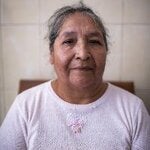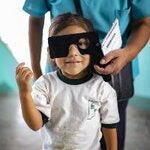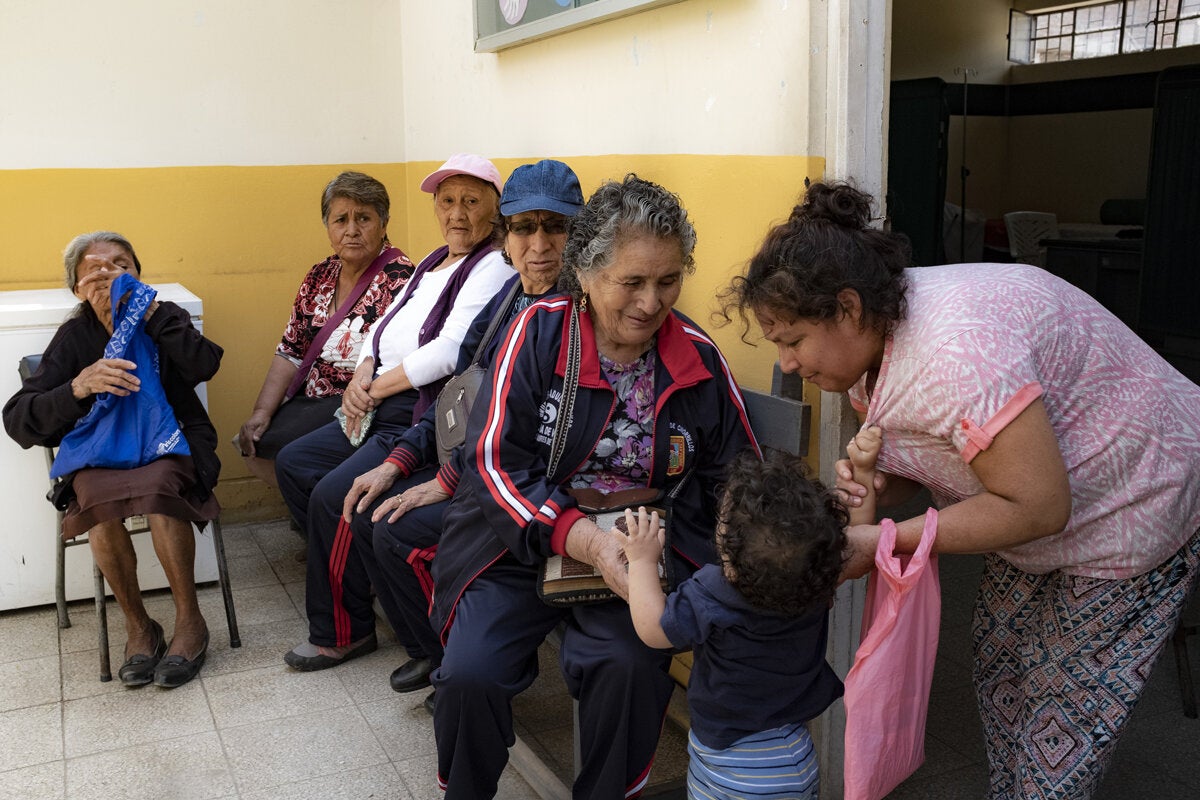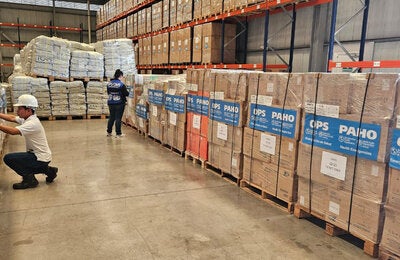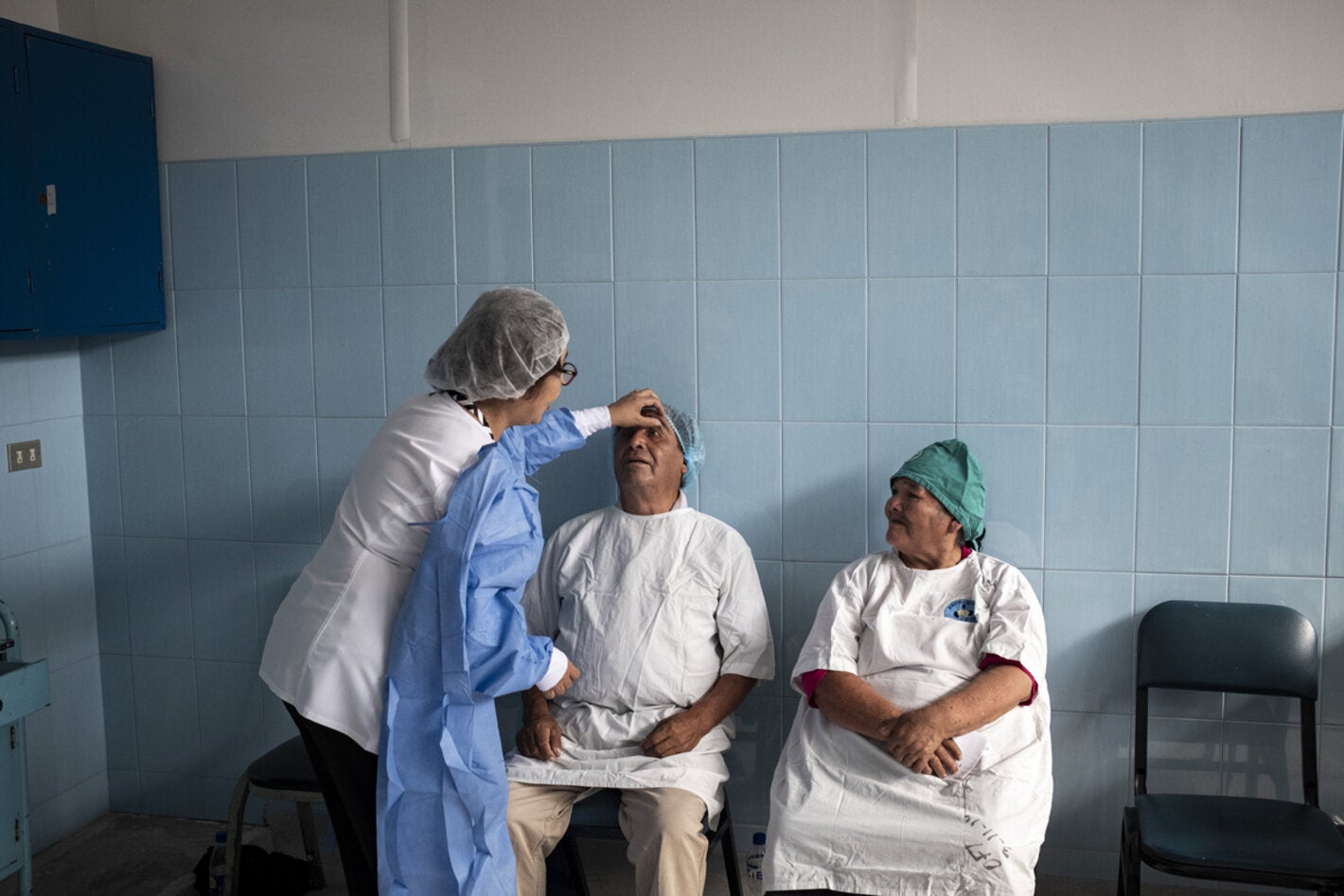
Lima, 11 October 2018 (PAHO/WHO) - Every day patients line up outside the Maternal and Child Health Centre Daniel Alcides Carrion in Villa Maria del Triunfo, a disadvantaged neighbourhood on the outskirts of Lima. They are there to have their eyes examined, to see if they may need treatment for an eye disease. While they wait, health care workers take the opportunity to share information about how to look out for common eye problems and what to do about them.
Gertrudis is one of the many people who has benefitted from the services offered by the Centre. She had a cataract in her right eye operated on at the Centre and she has returned to have a check-up before she has the same surgery on her left eye.
Expanding access to eye care services through maternal and child health facilities is just one of the Government of Peru’s many initiatives to address avoidable vision impairment and ensure comprehensive eye care services are available for everyone, regardless of age or the type of eye disease they may have.
Many people are missing out on eye care services
It is estimated that globally, 1.3 billion people live with varying levels of vision impairment. Among them 36 million people are blind A further 826 million people have near vision impairment, meaning it is difficult for them to perform close up work such as reading.
Globally, the majority of vision impairment is avoidable. For example, the two leading causes of vision impairment are refractive error and cataract; refractive error can be corrected with glasses and cataract surgery can restore vision. There are however, many people who do not have the same opportunities as Gertrudis, and consequently have to live with vision impairment.
In Peru, studies over the last 30 years have consistently shown that the majority of vision impairment could be avoided if people have access to eye care services. For this reason, the Ministry of Health has made eye care a priority and has been investing systematically in the area since the early 1980’s.
Strong government leadership is vital in addressing this challenge
The key responses prioritized by the Ministry of Health at the National Strategy on eye care and prevention of blindness have been the assessment of population eye care needs and data collection facilitating eye care planning and monitoring.
A population based study on vision impairment conducted in the Piura y Tumbes region in northern Peru between 2002 and 2003 found that 2.6% of people over the age of 50 years were blind, and that just over a quarter of people who needed cataract surgery received it. The findings from this study were used to estimate the national prevalence of vision impairment; this evidence was catalytic in informing the development of the first national programme for the prevention and control of blindness in 2006. “I remember when the results from the study first came out. There was a lot of attention on them and this really helped show where the gaps were and what needed to be done” says Dr Francisco Contrerras, former Director of the Instituto Nacional de Oftalmología.
The same study also highlighted the urgent need to address a rise in cases of cataract. In response to that in 2007, the Ministry developed a National Strategy for eye care and prevention of blindness plan to prevent cataract blindness. The plan prioritised training ophthalmologists to provide effective and low-cost cataract surgery. It also aimed to raise awareness among older people about the benefits of cataract surgery, many of whom did not know it could restore their vision. These focused efforts have since paid off, and the number of people who need cataract surgery and receive it has doubled between 2005 and 2011.
The Ministry has also taken a leadership role by facilitating the involvement of other stakeholders that also have an important role in eye care, such as the Ministry of Education, Ministry of Development and Social Inclusion, nongovernmental organisations and private providers of services. “It was always important to the Ministry that we prioritise eye care properly and make sure we work with the professionals in our sector. There is a lot of expertise here in Peru and we have found that by working together, we have been able to achieve much more” says Mr Harvy Honorio Morales, Coordinator of the National Strategy at the Ministry of Health.
Addressing a variety of population eye care needs is important
There are many eye diseases that can cause vision impairment and it can be challenging to determine what to prioritise, particularly when resources are scarce. In Peru, the Ministry of Health, via the National Health Strategy for Eye Health and Prevention of Blindness, has used evidence to prioritize vulnerable people throughout the life course and to help inform a staged approach to making sure eye care services meet a wide variety of population eye care needs.
A new study commissioned by the Ministry in 2011 among people 50 and older, the Population Study of Rapid Assessment of Blindness in Peru (ERCE Peru), found that while the prevalence of blindness had decreased by about 25%, a number of other challenges were emerging in its place. For example, the prevalence of vision impairment caused by diabetic retinopathy and uncorrected refractive error, especially in children, were increasing. Based on these findings a national eye health and prevention of blindness plan 2014 – 2020 was developed and funded.
This study also spurred the Ministry to take action to address diabetic retinopathy. One of the initial steps was to use the WHO tool for the assessment of diabetes and diabetic retinopathyto assess how well the health system could respond to the increasing number of people with diabetic retinopathy. As a result of this assessment, the Ministry was able to pin-point particular gaps and focus efforts on addressing them. For example, a subnational plan to prevent blindness caused by diabetic retinopathy was developed in 2012 for the La Libertad region of northern Peru, an area that had particularly high prevalence.
The Ministry of Health has also focused on vision impairment among children. From 2014-2016, a multi-sectorial program “Learn Healthy” was launched, through which the Ministry strengthened eye health promotion in public schools and offered detection, diagnosis, treatment and control of refractive error in children 3-11 years of age. These interventions were a part of the National Health Strategy for Eye Health and Prevention of Blindness, thereby guaranteeing their sustainability. Now, children like Aileen can have a free vision examination at school or at a nearby health care centre, making eye care more accessible.
Comprehensive eye care is achievable
Peru provides a good example of how a country can implement comprehensive eye care, including the important role of the Government to prioritise eye care and ensure there is a solid evidence base for making decisions. The Ministry of Health has worked to ensure eye care services are available not only to older people, but also to others including children, for whom early identification and intervention can make all the difference for quality of life later on. It has also shown that an evidence-based and strategic approach helps to ensure resources are focused on the greatest areas of need. The strong leadership from the Ministry of Health via the National Health Strategy for Eye Health and Prevention of Blindness and commitment to work with others, has ensured eye care services are better able to reach those who need them the most – including Jose who can now access eye care at his school. “We are proud of the work we have done with all the health professionals qualified at the national level to make sure our people can access eye care services, particularly those who need it the most, those in poorer and more rural areas” says Mr Morales.
For over twenty years, PAHO has been providing technical support to the Ministry of Health in Peru. This support has been crucial in supporting the National Health Strategy for Eye Health and Prevention of Blindness to collect solid evidence, and then determining how best to define priorities and allocate resources to expand access to eye care. It has also been instrumental in the development of national policies, plans and resolutions. “More recently the focus of PAHO technical cooperation has been on improving the delivery of eye care services and solution-based research” according to Dr Juan Carlos Silva, Regional Advisor PAHO.

